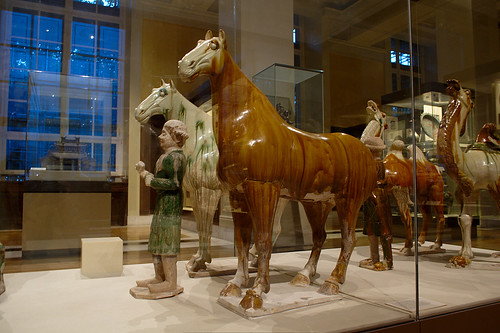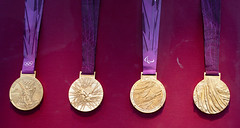Yesterday we went to the Fitzwilliam Museum in Cambridge to see their current exhibition of items from the tombs of Han Chinese royalty, which runs until November sometime.
Context
In China: The Han dynasty ruled China from approximately 200BC through to approximately 200AD. Most of the items in the exhibition were from the Western Han period, which was the first 200 years of the Han dynasty. China had been unified about 20 or so years before the Han came to power, under the Qin emperor who ruled for 10 years. After he died there was a period of civil war, followed by the first of the Han emperors taking power. Prior to the Qin emperor was a time called the Warring States Period.
Around the rest of the world: In Egypt we’re in the Ptolemaic period, so into the decline of the ancient Egyptian civilisation. In Europe the Romans are doing their thing – the Han era covers the time from around about the end of the wars with Carthage through to the end of the Republic (approximately the same time as the end of the Western Han period). Then the Eastern Han period is across the same time as the Roman Empire proper, until approximately the time of the reign of the Emperor Septimus Severus (about 50-100 years before the Roman Empire splits into Western & Eastern parts). Cribbing heavily from Wikipedia here for the Roman bit.
The Exhibition
No illustrations, coz the Fitzwilliam Museum don’t let you take pictures in the museum 🙁
The items on display were nearly all excavated either from tombs of members of the Han royalty or from the tombs of the royalty of the nearby kingdom of Nanyue. Nanyue was semi-automomous in this time period (but assimilated into China later), and their stuff was very clearly modelled on the Han items, but generally not quite as good quality.
The exhibition was laid out roughly following the layout of a tomb – so first was an antechamber with model warriors to protect the occupant. I was particularly struck by these – they even had some that were still painted & each was apparently made as an individual, because they believed that they would come to life in the afterlife so needed to be “people”. This area also showed how the tombs were intended to be protected from looting (including door locks & tales of killing all the workers on the tomb to protect the secret).
Next were a couple of rooms that contained items from the “palace rooms” part of the tomb – each tomb contained kitchens & entertainment rooms and even toilets with proper lifesize toilets in. Which I think was the most mindboggling part of the whole thing – their life in the afterlife clearly wasn’t going to be idealised, they were still going to need to do the less pleasant parts of real life like excretion! This area of the exhibition also included a lot of kitchenware, including ginger graters as well as several differents sorts of pots. Some of the pots were clearly heirlooms, as they were of older styles than the Han era, which was kinda cool 🙂 Also in this part of the exibition were models of entertainers – dancers & musicians – and models and/or real musical instruments and games. Also in this area of a tomb would be buried servants of the king, like his Food Inspector (and they had their own toilets in the tomb).
The next two rooms were “burial chambers” – one contained some of the funerary goods of a king of Nanyue (including his seals, some of which claimed he was Emperor, which probably didn’t go down that well with the Han Emperor who thought Nanyue was a vassal kingdom). The main item was a jade suit, which had contained the body of the king. Jade was both precious & symbolically important. It was thought to interact magically with the spirit world, and to protect the corpse from corruption. As well as this jade suit there were various jade ornaments around the body (and out in the first room there had been jade weapons for the tomb occupant to protect himself against the spirit world, as well as bronze & iron weapons for more mundane threats).
And the final room had the jade suit & jade coffin of a Han Emperor – good to see them in this order, as it immediately became clear that the Han items were much better quality. I admit I was a little underwhelmed by the jade coffin – I think for the Chinese of the time it would be more impressive because it was both magically and extremely expensive, but to me it looked like a tiled box. There were also more funerary goods – like jade ornaments, jade covered “pillows”.
I’ll criticise a bit here about the labelling – I thought the labels were often not obvious to find & weren’t always particularly informative. This is partly my fault, as I’m sure the audio guide had more info but I really dislike audio guides so I don’t use them. (Pacing is the problem, mostly, and often it seems to be only extra info on the stuff I wasn’t intrigued by.)
Overall a very interesting exhibition, I learnt a lot about that era of Chinese history that I didn’t know before & there were some very impressive items. I think my favourites were the painted terracotta warriors & some of the beautifully carved jades.
Other Stuff
Retail: I picked up the book of the exhibition (only available in hardcover, a shame), and some postcards. There were also quite a lot of classy souvenirs too, tho mostly out of my price range for a whim 🙂
Stuff I should know more about: Chinese history in general – I need to get a book covering the whole sweep of it, I know very little & it’s pretty patchy.
Other exhibits: I also went to look at their small exhibition of pottery from medieval Cyprus. Which generally wasn’t to my taste, but I thought the display of how the patterns were made and what the glazing techniques were was interesting.
We also looked at the Egyptian stuff (surprise surprise) – in particular the lid of Rameses III’s sarcophagus (the base is in the Louvre), and a coffin set from the 21st Dynasty.
Other places: A trip to Cambridge isn’t complete with some nostalgia side-trips … so lunch in Tatties (not the same as it was when we were there), a drink in The Mitre & dinner at Browns 🙂

